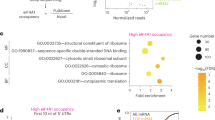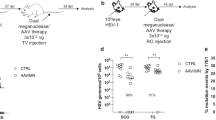Abstract
The 55-kDa gene product from subgroup C adenovirus type 5 (Ad5) early region 1 (E1B-55kDa) plays a central role in the oncogenic transformation of primary rodent cells primarily by inactivating transcriptional and presumably other functional properties of the tumor suppressor protein p53. We have previously shown that Ad5 E1B-55kDa possesses a leucine-rich nuclear export signal (NES), which confers rapid nucleocytoplasmic shuttling via the CRM1-dependent export pathway. In this study we report that an export-deficient mutant of the viral protein (E1B-NES) substantially enhances focus formation of primary baby rat kidney cells in combination with Ad E1A. Transformed rat cells stably expressing the E1B-NES protein exhibited increased tumorigenicity and accelerated tumor growth in nude mice compared to transformants containing the wild-type E1B product. This ‘gain of function’ correlated with enhanced inhibition of p53 transactivation in transient reporter assays and the accumulation of the mutant protein and p53 in several dot-like subnuclear aggregates. Interestingly, these structures also contained a large fraction of cellular promyelocytic leukemia protein (PML), a known regulator of p53. These data indicate that E1B-NES promotes oncogenic transformation by combinatorial mechanisms that involve modulation of p53 in the context of PML nuclear bodies. In sum, these results extend our previous observation that inhibition of PML activities by E1B-55kDa is required for efficient focus formation and provide further support for the view that blocking p53 transcriptional functions is the principal mechanism by which the Ad protein contributes to complete cell transformation in conjunction with Ad E1A.
This is a preview of subscription content, access via your institution
Access options
Subscribe to this journal
Receive 50 print issues and online access
$259.00 per year
only $5.18 per issue
Buy this article
- Purchase on Springer Link
- Instant access to full article PDF
Prices may be subject to local taxes which are calculated during checkout






Similar content being viewed by others
References
Bernardi R and Pandolfi PP . (2003). Oncogene, 22, 9048–9057.
Bernards R, Houweling A, Schrier PI, Bos JL and van der Eb AJ . (1982). Virology, 120, 422–432.
Bernards R, Schrier PI, Houweling A, Bos JL, van der Eb AJ, Zijlstra M and Melief CJ . (1983). Nature, 305, 776–779.
Bernards R and van der Eb AJ . (1984). Biochim. Biophys. Acta, 783, 187–204.
Blair-Zajdel ME and Blair GE . (1988). Oncogene, 2, 579–584.
Borden KL . (2002). Mol. Cell. Biol., 22, 5259–5269.
Brown CR, Doxsey SJ, White E and Welch WJ . (1994). J. Cell. Physiol., 160, 47–60.
Debbas M and White E . (1993). Genes Dev., 7, 546–554.
Dosch T, Horn F, Schneider G, Krätzer F, Dobner T, Hauber J and Stauber RH . (2001). J. Virol., 75, 5677–5683.
Doucas V, Ishov AM, Romo A, Juguilon H, Weitzman MD, Evans RM and Maul GG . (1996). Genes Dev., 10, 196–207.
Endter C and Dobner T . (2004). Curr. Top. Microbiol. Immunol., 273, 163–214.
Endter C, Kzhyshkowska J, Stauber R and Dobner T . (2001). Proc. Natl. Acad. Sci. USA, 98, 11312–11317.
Fogal V, Gostissa M, Sandy P, Zacchi P, Sternsdorf T, Jensen K, Pandolfi PP, Will H, Schneider C and Del Sal G . (2000). EMBO J., 19, 6185–6195.
Goodrum FD, Shenk T and Ornelles DA . (1996). J. Virol., 70, 6323–6335.
Graham FL and van der Eb AJ . (1973). Virology, 52, 456–467.
Grand RJ, Lecane PS, Roberts S, Grant ML, Lane DP, Young LS, Dawson CW and Gallimore PH . (1993). Virology, 193, 579–591.
Grand RJ, Parkhill J, Szestak T, Rookes SM, Roberts S and Gallimore PH . (1999). Oncogene, 18, 955–965.
Guo A, Salomoni P, Luo J, Shih A, Zhong S, Gu W and Paolo Pandolfi P . (2000). Nat. Cell. Biol., 2, 730–736.
Harlow E, Franza Jr BR and Schley C . (1985). J. Virol., 55, 533–546.
Harlow E, Pim DC and Crawford LV . (1981). J. Virol., 37, 564–573.
Hofmann TG and Will H . (2003). Cell Death Differ, 10, 1290–1299.
Hutton FG, Turnell AS, Gallimore PH and Grand RJ . (2000). Oncogene, 19, 452–462.
König C, Roth J and Dobbelstein M . (1999). J. Virol., 73, 2253–2262.
Krätzer F, Rosorius O, Heger P, Hirschmann N, Dobner T, Hauber J and Stauber RH . (2000). Oncogene, 19, 850–857.
Leppard KN and Everett RD . (1999). J. Gen. Virol., 80, 997–1008.
Lethbridge KJ, Scott GE and Leppard KN . (2003). J. Gen. Virol., 84, 259–268.
Lin J, Chen J, Elenbaas B and Levine AJ . (1994). Genes Dev., 8, 1235–1246.
Liu Y, Colosimo AL, Yang XJ and Liao D . (2000). Mol. Cell. Biol., 20, 5540–5553.
Lowe SW and Ruley HE . (1993). Genes Dev., 7, 535–545.
Maheswaran S, Englert C, Lee SB, Ezzel RM, Settleman J and Haber DA . (1998). Oncogene, 16, 2041–2050.
Mak I, Mak S and Benchimol S . (1988). Virology, 163, 201–204.
Martin ME and Berk AJ . (1998). J. Virol., 72, 3146–3154.
Martin ME and Berk AJ . (1999). Mol. Cell. Biol., 19, 3403–3414.
Mitsudomi T, Steinberg SM, Nau MM, Carbone D, D'Amico D, Bodner HK, Oie HK, Linnoila RI, Mulshine JL, Minna JD and Gazdar AF . (1992). Oncogene, 7, 171–180.
Moore M, Horikoshi N and Shenk T . (1996). Proc. Natl. Acad. Sci. USA, 93, 11295–11301.
Nevels M, Rubenwolf S, Spruss T, Wolf H and Dobner T . (1997). Proc. Natl. Acad. Sci. USA, 94, 1206–1211.
Nevels M, Rubenwolf S, Spruss T, Wolf H and Dobner T . (2000). J. Virol., 74, 5168–5181.
Nevels M, Spruss T, Wolf H and Dobner T . (1999a). Oncogene, 18, 9–17.
Nevels M, Täuber B, Kremmer E, Spruss T, Wolf H and Dobner T . (1999b). J. Virol., 73, 1591–1600.
Nevels M, Täuber B, Spruss T, Wolf H and Dobner T . (2001). J. Virol., 75, 3089–3094.
Pearson M, Carbone R, Sebastiani C, Cioce M, Fagioli M, Saito S, Higashimoto Y, Appella E, Minucci S, Pandolfi PP and Pelicci PG . (2000). Nature, 406, 207–210.
Punga T and Akusjärvi G . (2000). FEBS Lett., 476, 248–252.
Sabbatini P, Lin J, Levine AJ and White E . (1995). Genes Dev., 9, 2184–2192.
Sarnow P, Ho YS, Williams J and Levine AJ . (1982a). Cell, 28, 387–394.
Sarnow P, Sullivan CA and Levine AJ . (1982b). Virology, 120, 510–517.
Sawada Y, Raska Jr K and Shenk T . (1988). Virology, 166, 281–284.
Teodoro JG and Branton PE . (1997). J. Virol., 71, 3620–3627.
Teodoro JG, Halliday T, Whalen SG, Takayesu D, Graham FL and Branton PE . (1994). J. Virol., 68, 776–786.
van den Heuvel SJL, The SI, Klein B, Jochemsen AG, Zantema A and van der Eb AJ . (1992). J. Virol., 66, 591–595.
van den Heuvel SJL, van Laar T, Kast WM, Melief CJM, Zantema A and van der Eb AJ . (1990). EMBO J., 9, 2621–2629.
Wang J, Shiels C, Sasieni P, Wu PJ, Islam SA, Freemont PS and Sheer D . (2004). J. Cell Biol., 164, 515–526.
Wienzek S, Roth J and Dobbelstein M . (2000). J. Virol., 74, 193–202.
Yew PR and Berk AJ . (1992). Nature, 357, 82–85.
Yew PR, Kao CC and Berk AJ . (1990). Virology, 179, 795–805.
Yew PR, Liu X and Berk AJ . (1994). Genes Dev., 8, 190–202.
Zantema A, Fransen JA, Davis OA, Ramaekers FC, Vooijs GP, DeLeys B and van der Eb AJ . (1985a). Virology, 142, 44–58.
Zantema A, Schrier PI, Davis OA, van Laar T, Vaessen RT and van der Eb AJ . (1985b). Mol. Cell. Biol., 5, 3084–3091.
Zhao LY, Colosimo AL, Liu Y, Wan Y and Liao D . (2003). J. Virol., 77, 11809–11821.
Zhao LY and Liao D . (2003). J. Virol., 77, 13171–13181.
Acknowledgements
We thank Drs B Wolf for LMB, A Levine for MAb 2A6, L de Jong for MAb 5E10, A Zantema for MAb 9C10, R Stauber for plasmid pF143Rexp21, and D Büchner and S Allmeier for able technical assistance. This work was supported by the Deutsche Forschungsgemeinschaft (Do 343/4-4) and by the Fonds der Chemischen Industrie (FCI).
Author information
Authors and Affiliations
Corresponding author
Rights and permissions
About this article
Cite this article
Endter, C., Härtl, B., Spruss, T. et al. Blockage of CRM1-dependent nuclear export of the adenovirus type 5 early region 1B 55-kDa protein augments oncogenic transformation of primary rat cells. Oncogene 24, 55–64 (2005). https://doi.org/10.1038/sj.onc.1208170
Received:
Revised:
Accepted:
Published:
Issue Date:
DOI: https://doi.org/10.1038/sj.onc.1208170
Keywords
This article is cited by
-
Sp100A is a tumor suppressor that activates p53-dependent transcription and counteracts E1A/E1B-55K-mediated transformation
Oncogene (2016)
-
PML isoforms IV and V contribute to adenovirus-mediated oncogenic transformation by functionally inhibiting the tumor-suppressor p53
Oncogene (2016)
-
Cross-talk between phosphorylation and SUMOylation regulates transforming activities of an adenoviral oncoprotein
Oncogene (2013)
-
SUMO modification of E1B-55K oncoprotein regulates isoform-specific binding to the tumour suppressor protein PML
Oncogene (2010)
-
Adenovirus type 5 early region 1B 55-kDa oncoprotein can promote cell transformation by a mechanism independent from blocking p53-activated transcription
Oncogene (2008)



